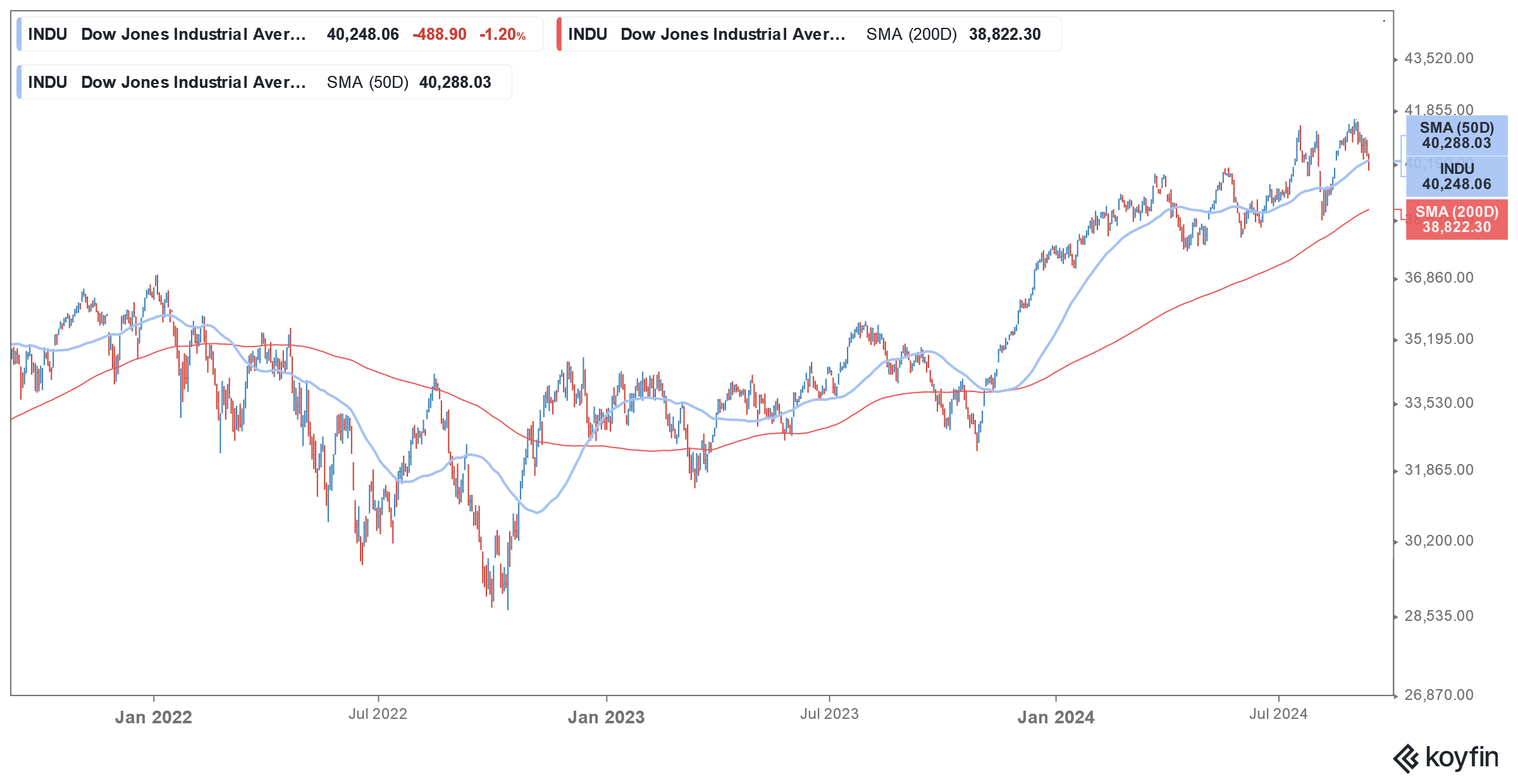US Stocks Extend Losses as Data Showed Core Inflation Picked Up in August
Please note that we are not authorised to provide any investment advice. The content on this page is for information purposes only.
US stocks extended their losses and the Dow Jones was down over 500 points in early price action today after data released by the Bureau of Labor Statistics (BLS) showed that core inflation picked up in August even as the overall consumer price index (CPI) fell to 2.5% which is the lowest since early 2021.
Data showed that CPI rose 2.5% on an annualized basis last month while the month-on-month rise was 0.2% which was in line with estimates. In its release, the BLS blamed higher shelter costs – which rose 0.5% last month – for driving up the CPI. Meanwhile, the so-called core inflation that excludes the volatile food and energy prices rose 0.3% month-on-month which was higher than the 0.2% increase in July.
Core Inflation Inched Up in August
Commenting on the data, Steve Sosnick, chief strategist at Interactive Brokers said, “Taken on its own, [CPI] is not terrible.” He however added, “But what the market did not need was a core reading that was higher than expected. I think it was a big splash of cold water on a market that was hopeful that a 50 basis-point rate cut might be in the cards. Those expectations have all but evaponfrated.”
Notably, the US Federal Open Market Committee (FOMC) meeting is scheduled for September 17-18 where the US central bank is widely expected to cut rates. However, after the uptick in August core inflation, a 50 basis point cut now looks off the table.
Seema Shah, chief global strategist at Principal Asset Management said, “This isn’t the CPI report the market wanted to see. With core inflation coming in higher than expected, the Fed’s path to a 50 basis point cut has become more complicated.”
Shah added, “The number is certainly not an obstacle to policy action next week, but the hawks on the committee will likely seize on today’s CPI report as evidence that the last mile of inflation needs to be handled with care and caution – a formidable reason to default to a 25 basis points reduction.”
US Job Market Has Also Cooled
Notably, the August inflation numbers are among the last key data points before the upcoming Fed meeting. US Nonfarm payroll data released last week showed that the world’s largest economy added a mere 142,000 jobs in August. While the numbers were still better than in July when nonfarm payrolls slumped to 89,000, they were significantly below the 161,000 that economists were expecting.
Also, the Bureau of Labor Statistics downwardly revised the employment numbers for June and July by 118,000 and 25,000 respectively. The overall unemployment rate was 4.2% in August – which was in line with estimates. However, the real unemployment rate was 7.9% which was the highest since October 2021.
Commenting on the data, Dan North, senior economist for North America at Allianz Trade said, “I don’t like this a whole lot. It’s not disaster, but it’s below expectations on the headline, and what really bothers me is the revisions.” He added, “This is certainly going the wrong way.”
US Inflation Has Come Off Its Highs
While US inflation has gradually come down after peaking at 9.1% in June 2022, economic indicators suggest a weakening of the economy. In his prepared remarks for the Senate testimony earlier this year, Powell admitted, “In light of the progress made both in lowering inflation and in cooling the labor market over the past two years, elevated inflation is not the only risk we face.”
He added, “Reducing policy restraint too late or too little could unduly weaken economic activity and employment.”
Powell and other Fed officials have raised multiple times that the US central bank won’t wait for inflation to drop to 2% before it starts cutting rates.
Jamie Dimon Does Not Rule Out a Stagflation
There are also fears that the US economy could witness stagflation – a scenario where economic growth slows down while inflation is rising.
Speaking at a fall conference from the Council of Institutional Investors in Brooklyn, New York yesterday, JPMorgan Chase CEO Jamie Dimon said, “I would say the worst outcome is stagflation — recession, higher inflation.” He added, “And by the way, I wouldn’t take it off the table.”
He said that high budget deficits and infrastructure spending are recessionary in nature while adding, “So, it’s hard to look at [it] and say, ‘Well, no, we’re out of the woods.’ I don’t think so.”
Earlier this year, Fed chair Powell also sounded alarm over the ever-rising US debt pile. “It’s probably time, or past time, to get back to an adult conversation among elected officials about getting the federal government back on a sustainable fiscal path,” said Powell.
He added, “In the long run, the U.S. is on an unsustainable fiscal path. The U.S. federal government is on an unsustainable fiscal path. And that just means that the debt is growing faster than the economy. So, it is unsustainable. I don’t think that’s at all controversial. And I think we know that we have to get back on a sustainable fiscal path.”
Fed Changed Its Inflation Targeting Approach in 2020
Notably, in 2020, the US Central Bank changed its inflation-targeting approach and now targets an average inflation of 2% rather than chasing absolute numbers. The mandate gives Powell and co. more leeway in deciding on monetary policy, unlike previously where its mandate was to keep inflation below 2% at all times.
Meanwhile, with core inflation picking up in June and most data points suggesting a rapid cooling of the US economy, the Fed’s job only seems to have gotten harder.






